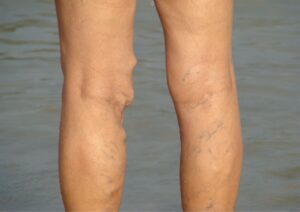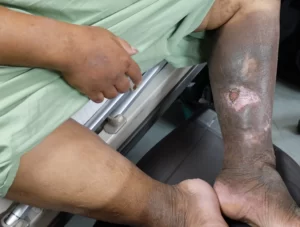Varicose veins are a common condition that affects many people, especially as they age. These enlarged, dilated veins can cause a variety of symptoms, including aching, swelling, and discomfort in the legs.
Over time, untreated varicose veins can lead to more serious complications such as ulcers, blood clots, and skin discoloration. By understanding the symptoms and progression of varicose veins, individuals can work with their healthcare provider to develop a treatment plan that will relieve discomfort, improve circulation, and prevent long-term complications associated with this common vascular condition.

Stage 1: Spider Veins
Description: This initial stage features small, thread-like superficial veins visible just under the skin, often red, blue, or purple.
Symptoms: Usually cosmetic, with little to no discomfort. Some may experience mild itching or burning
Stage 2: Varicose Veins
Description: Veins become more prominent, bulging veins that are twisted and larger than spider veins. These veins can be easily felt under the skin.
Symptoms: Aching, throbbing, and heaviness in the legs, especially after standing or sitting for long periods. Swelling around the ankles and lower legs may also occur.


Stage 3: Edema
Description: Persistent swelling (oedema) starts to appear in the lower legs and ankles due to compromised blood flow and increased pressure in the veins.
Symptoms: Swelling is more noticeable and can cause discomfort and skin changes such as tightness and shininess.
Stage 4: Skin Changes
Description: The skin’s surface around the varicose veins begins to change colour and texture, often becoming brownish or leathery.
Symptoms: Symptoms can include eczema-like conditions, itching, redness, and skin thickening. In severe cases, lipodermatosclerosis, a hardening of the fat layer under the skin, can occur.

Stage 6: Active Ulceration
Description: Open sores or leg ulcers develop on the skin, often around the ankles. These ulcers are the result of long-term pressure and fluid buildup.
Symptoms: Ulcers are painful, prone to infection, and difficult to heal without proper treatment. The skin around the ulcers may be inflamed and swollen.

How quickly do varicose veins progress?
The progression of varicose veins, often due to chronic venous insufficiency, can vary significantly from person to person, influenced by factors such as genetics, lifestyle, and overall health. Here are some key points regarding the rate of progression:
Factors Influencing Progression
Several risk factors influence the progression of varicose veins, including genetics, age, lifestyle, and hormonal changes.
Genetics: A family history of varicose veins can increase the likelihood of developing the condition at a younger age and experiencing faster progression.
Age: The risk of varicose veins increases with age, and symptoms can worsen more rapidly in older individuals.
Lifestyle: Factors such as prolonged standing or sitting, lack of exercise, and obesity can accelerate the progression of varicose veins.
Hormonal Changes: Pregnancy, menopause, and hormonal treatments can influence the rate of vein dilation and incompetence.
Rate of Progression
Initial Development: Varicose veins can develop slowly over years. Initially, individuals may notice minor symptoms like occasional leg heaviness or mild discomfort.
Early Stages: In the early stages, spider veins and mild varicose veins may appear, often progressing gradually over several months to years.
Moderate Progression: As the condition progresses, symptoms such as pain, swelling, and visible vein enlargement can become more pronounced. This stage can take several years to develop.
Advanced Stages: In more advanced stages, complications such as skin changes, oedema, and ulceration can occur. The progression to these stages can vary but often takes many years without intervention, especially when deep veins are involved.
Treatment Options by Stages of Varicose Vein Disease
Venous disease, including varicose vein disease, progresses through various stages, each requiring specific treatment options. Here’s a detailed look at the treatment strategies for each stage:
Stage 1: Spider Veins
Treatment Options:
1. Sclerotherapy:
– Injection of a solution into the vein causing it to collapse and fade.
– Effective and widely used for treating spider veins.
2. Laser Therapy:
– Uses focused light to target and destroy the veins.
– Non-invasive and effective for small spider veins.
3. Lifestyle Changes:
– Regular exercise, leg elevation, and avoiding prolonged standing can help reduce symptoms.
Stage 2: Varicose Veins
Treatment Options:
1. Compression Stockings:
– Helps improve circulation and reduce swelling and discomfort.
– Should be worn daily, especially when standing or sitting for long periods.
2. Endovenous Laser Ablation (EVLA):
– Minimally invasive procedure using laser energy to close off the varicose vein.
– Effective with quick recovery times.
3. Radiofrequency Ablation (RFA):
– Uses heat generated by radio waves to close off varicose veins.
– Minimally invasive and effective.
Stage 3: Edema
Treatment Options:
1. Medical Management:
– Diuretics may be prescribed to reduce fluid retention.
– Compression therapy to manage swelling.
2. Lifestyle Changes:
– Elevate legs to reduce swelling.
– Maintain a healthy weight to lessen vein pressure.
Stage 4: Skin Changes
Treatment Options:
1. Topical Treatments:
– Corticosteroid creams to reduce inflammation and itching.
– Emollients to keep skin moisturised and prevent cracking.
2. Advanced Compression Therapy:
– Using compression bandages or custom-fit stockings to manage symptoms.
Stage 5: Healed Ulceration
Treatment Options:
1. Maintenance Therapy:
– Continue using compression stockings to prevent recurrence.
– Regular monitoring and skin care to avoid new ulcers.
2. Lifestyle Changes:
– Continued emphasis on weight management and exercise.
3.Advanced Procedures:
– Endovenous laser therapy or radiofrequency ablation to treat the underlying venous insufficiency.
Stage 6: Active Ulceration
Treatment Options:
1. Wound Care:
– Specialized wound dressings to promote healing.
– Regular cleaning and dressing changes.
2. Surgical Intervention:
Vein surgery to remove or close off affected veins, especially in cases complicated by deep vein thrombosis, may be necessary.
Skin grafts may be necessary for severe cases.
3. Advanced Procedures:
– Endovenous laser therapy or radiofrequency ablation to treat the underlying venous insufficiency.











